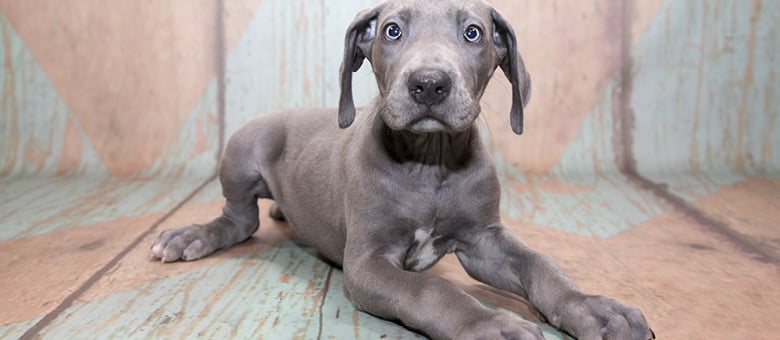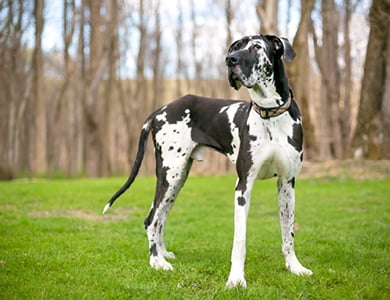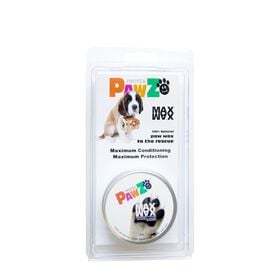Famous great Danes include Scooby-Doo and Marmaduke. Although its name gives the impression that the breed comes from Denmark, it is in fact originally from Germany. The name “great Dane” dates back to the 1700s. French naturalist Georges-Louis Leclerc, Comte de Buffon, coined the breed’s name while he was travelling in Denmark. Other names include Deutsche Dogge and German mastiff.
Physical appearance
Tall, regal, dignified, strong, elegant, well-proportioned, smooth muscular build and powerful are among the terms used to describe great Danes. This giant is unique in that its general conformation must be so well balanced that it never appears clumsy, but rather elegant. It is the Apollo of dogs. Bold and courageous, it is never timid, and is friendly and self-assured. This combination of physical and mental features gives great Danes their characteristic majesty. It is especially true of this breed that there is a high degree of masculinity among males and femininity among females. The male appears more massive overall than its female counterpart appears, and has a larger bone structure. In the ratio between length and height, the great Dane should be as square as possible. In females, the body can be somewhat longer.
Males should be at least 76 cm (30 in.) at the shoulders, but can measure up to 81 cm (32 in.) or more, provided they are well proportioned for their height. Females should be at least 71 cm (28 in.) tall, but 76 cm (30 in.) or more is preferable, again provided they are well proportioned.
The head is long, narrow, distinguished, expressive and finely chiselled, especially below the eyes, where there is a sharply pronounced stop. The muzzle should have full lips and be as blunt vertically as possible in front. The ears should be set high on the head and folded forward, close to the cheek. Originally, the ears were cropped to a point to avoid being torn by boars’ tusks during hunting. The tail, however, is never cropped.
The hair is very short, dense, smooth and glossy. The breed’s accepted coat colours are as follows: fawn, brindle, blue, black, harlequin and Boston. The merle coat colour pattern also exists for this breed, although it is not approved because it is associated with a number of health issues, including deafness, as well as blindness and other debilitating eye problems.

Life expectancy and health
Great Danes, like most giant breeds, have a fairly slow metabolism. They have health problems that are common to large breeds, including gastric torsion (dog bloat). Hip dysplasia, dilated cardiomyopathy and various congenital heart diseases are often observed in great Danes. The breed can also develop wobbler syndrome, a neurologic disease that affects their cervical spine, causing coordination problems. The average life lifespan of a great Dane is 6 to 8 years; however, some have been known to reach 10 years of age or more.
Energy level and temperament
Great Danes may appear calm, but they require daily exercise adapted to their age. A brisk walk two or three times a day may be enough. A great Dane may be a good hiking or running companion, but you should wait until the dog is two years old to avoid damaging its growing joints and keep in mind that, for the most part, it is not a very sporty dog breed.
Great Danes have a friendly nature and are generally sociable with other animals when they are in contact from a young age. Since it is such a large and powerful breed, obedience training is required. Socialization is also very important in order to gradually expose the puppy to a wide range of people, places and situations, which will help it grows up to be a well-adapted adult dog. Great Danes are sociable, friendly and eager to please. They respond well to firm and consistent training methods. They need human contact and affection from their owners.

Maintenance and grooming
Great Danes shed lightly year-round; however, given their size, the amount of hair loss is quite significant. Weekly brushing with a rubber-grooming glove will help keep hair loss to a minimum. During shedding season, once or twice a year, daily brushing is more appropriate. Great Danes require only occasional bathing. As with all breeds, the nails must be trimmed regularly, since long nails can cause pain and foot problems.
Origins
Great Danes arrived in Europe in the 4th century with the Alans (Iranian nomadic herdsmen). Ancestors to the modern great Dane lost their war support role in the Late Middle Ages when they were recognized for their foxhunting and especially boar hunting skills. The immediate ancestor to the modern great Dane would have been crossbred with wolfhounds, likely Irish wolfhounds, given their similar size. Great Danes were of intermediate conformation between a powerful and energetic mastiff and a speedy hound. These dogs were bred in the courts of German nobility starting in the early 17th century. In 1870, Chancellor Bismarck, who had two great Danes, greatly increased the popularity of the German breed. In 1878, a Berlin committee of breeders started to group the characteristics of “Dogge” (mastiffs) under an independent German breed, known as “Deutsche Doggen” (German mastiffs). The breed was confirmed in 1880 when the first standard was published. The first dog show in which the great Dane was authorized to compete dates back to 1963 in Hamburg.
For more information, contact a registered breeder at the Canadian Kennel Club, who can answer all your questions. You can also contact the organization for information on breeders and the various breed clubs in Quebec and elsewhere in Canada.






